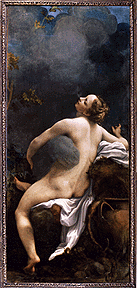Antonio da Correggio: "Jupiter and Io" (1532).
The painting depicts Jupiter in the form of a cloud as he steals a kiss from the beautiful river nymph Io.
Click on image for full size
Kunsthistorishes Museum, Vienna
Io
Io was a priestess of the Roman goddess Juno. Juno was the jealous wife of Jupiter, the
king of the gods.
Jupiter was very unfaithful. When Jupiter fell in love with Io,
he changed himself into the shape of a dark cloud to hide himself from his jealous wife Juno.
However, Juno looked down on earth and noticed the small cloud. She knew it was her husband. As soon as Juno arrived, Jupiter immediately transformed Io
into
a white cow to avoid his wife's wrath. But Juno tied the poor cow and sent her faithful servant Argus to watch over
Io. Argus had a hundred eyes and only a few were ever closed at any time.
To free Io, Jupiter sent his son Mercury to sing and tell boring stories to make Argus sleep with all his eyes. Mercury told so many stories that finally Argus close all his hundred
eyes. Only then did Mercury kill Argus and untie Io who ran home free. Yet when Juno
discovered what had occurred, she was so furious that she sent a vicious gadfly to
sting the cow forever.
Meanwhile, Io who was still prisoner into the shape of a cow could not get rid of the malicious gadfly. Finally, after Jupiter vowed to no longer pursue his beloved Io,
Juno released Io from her inhuman prison, and Io settled in Egypt, becoming the first queen of Egypt.
The Jovian moon Io was named for the mythological character Io by
Johannes Kepler, and Simon Marius. And finally, when Voyager 1 passed Io in March 1979
and imaged the surface, the image clearly showed the hoof print of a heifer!
You might also be interested in:
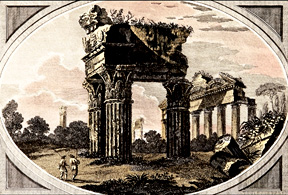
In Roman mythology, Jupiter (Zeus in Greek mythology) was the king of heaven and Earth and of all the Olympian gods. He was also known as the god of justice. He was named king of the gods in the special
...more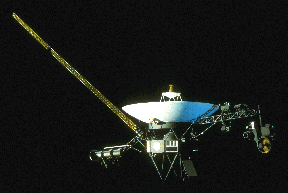
The rare arrangement of planets Jupiter, Saturn, Uranus, and Neptune in the 1980's made it possible for the Voyager spacecrafts to visit them over a 12 year span instead of the normal 30. They used gravity
...more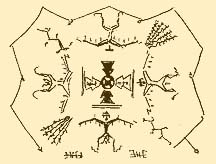
Ahsonnutli was the sky father and chief god for the Navajo. He created heaven, Earth, and the sky. Each of the four directions, or cardinal points, are supported by a giant. Each direction is symbolized
...more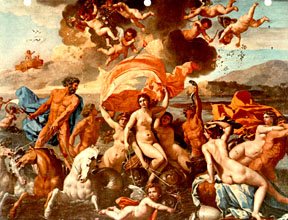
Amphitrite was one of the sea-nymphs called the Nereids. One day the sea god Poseidon saw her dancing and fell desperately in love with her. He promptly asked her to marry him but unfortunately she refused.
...more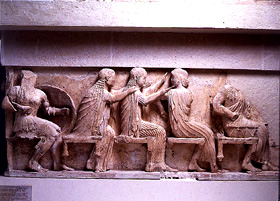
Aphrodite was the Greek goddess of love and beauty. She was known to the Romans as Venus. To the perfection of her figure and the purity of her features she added an innocent grace. On her sweet face she
...more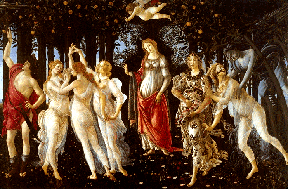
In Greek mythology, Apollo was the son of Jupiter(in Greek Zeus) and Leto (Letona). He was the god of the Sun, logic, and reason, and was also a fine musician and healer. Leto travelled all over Greece
...more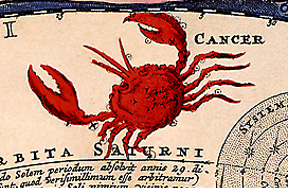
According to an ancient Greek legend, the figure of a gigantic crab was placed in the nighttime sky by the goddess Hera to form the constellation Cancer. Hera swore to kill Heracles, the most famous Greek
...more


